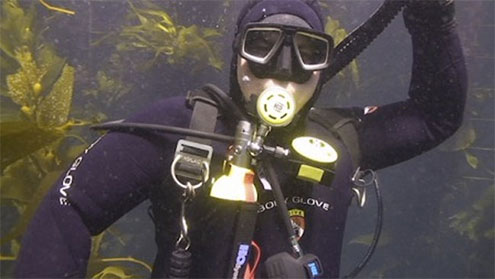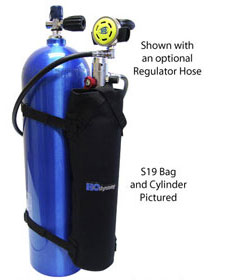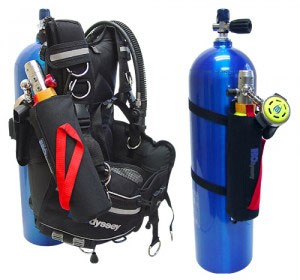Buying an Emergency Air Source

Imagine you are in the middle of a 25 metre dive and being so engrossed in the surroundings, you have neglected to frequently check your air pressure gauge. Then you run out of air! Your dive buddy is quite some distance away with his/her back turned to you busy taking another picture, too engrossed and not near enough for you to signal that you're out of air. You know you don't have enough air to surface, and performing an emergency ascent from this depth would be highly risky. Even if you did manage to signal your buddy for air, the chances are that he/she too would be low on air as well. With two of you using the one air source, the cylinder would run out quite quickly.
However, if you have an Emergency Air Source (EAS) in the form of a pony bottle, or similar, you get to easily survive this potentially deadly situation. You simply switch to your redundant air source tank, get your buddy's attention, and both of you ascend slowly together, do your safely stop, and then surface. All good!
Maybe you're a hookah diver and suddenly you're out of air because that cheap, non-lockable quick connect fitting decoupled, or the surface supply compressor stopped working. The correct capacity redundant air source solution will get you back to the surface safely.
There are many way to run out of air, including:
- Forgetting to watch the time and staying down too long.
- Using air quicker than planned due to overshooting depth, getting caught in a current, getting lost, nitrogen narcosis, diving in cold water, getting caught in kelp or fishing line.
- Sudden regulator malfunction due to corrosion or too much time between overhaul.
- O-ring failure on any of the First stage regulator ports.
- Regulator stuck in "free-flow" due to foreign particles or sand.
- Regulator "freezing up" in cold water leaving you suddenly without air.
- Stuck Pressure Gauge reflecting incorrect pressure in your cylinder.
- Air cut off due to tank valve not being turned on all the way.
- Rupture of scuba tank O-ring due to misalignment or wear.
- Second stage regulator diaphragm develops a tear or slips out of place.
- O-ring failure on BC air inflator or valve stuck in the open position.
- Burst disc failure on scuba tank valve due to corrosion or age.
- Clogged filter on first stage regulator due to sediment or rust from tank.
- Leak develops at any one of the High or Low pressure hose fittings.
- Mouthpiece on second stage suddenly coming off regulator.
- O-ring failure on pressure gauge.
- Rupture of either High or Low Pressure hoses.
- O-ring failure on Octopus regulator.
- Rental cylinder not filled completely.
- Damaged first stage regulator due to falling object / impact.
- High or Low pressure hose cut or severed on sharp rock / impediment.
(Source: Dive accident logs, published articles in dive magazines.)
 |
Pony cylinders are also invaluable redundancy air tools when performing deep dives. Many dive operators will suspend a drop tank for deep dives at 3 to 5 metres (10-15 ft) however many may not. Even if they do, you have to locate your drop tank in-order to use it at your safety stop, and sometimes when you run out of air, you just aren't nearby the dive boat. This is another situation where a pony tank will help you successfully perform your safety stop.
Pony bottles are a great way to be self reliant and prepared for eventualities rather than rely on someone else in-case of an emergency. A skydiver wears a reserve parachute, a scuba diver should have a reserve breathing system.
Are You Diving Solo?
For solo scuba divers, an emergency / redundant / alternative air source solution is an essential way to stay safe by being self-reliant and prepared for an emergency.
"But I don't dive solo," we hear you say. Really! If you're diving with a keen underwater photographer, or a dive buddy focused on catching a cray, gathering abalone or scallops, more often than not you're really diving solo. So be prepared and have your own pony cylinder!
Air Reserve Capacity vs Max Depth
All of the training agencies recommend you have an extra air source on dives deeper than 30 metres (100 feet).
For hookah divers and scuba divers staying less than 18 metres (60 feet) deep, we suggest a minimum EAS cylinder size of 0.9 litre (6 cubic feet). We recommend an EAS cylinder size of 1.9 litre (13 cubic feet).
For hookah divers and scuba divers staying less than 30 metres (100 feet) deep, we suggest a minimum EAS cylinder size of 1.9 litre (13 cubic feet). We recommend an EAS cylinder size of 2.7 litre (19 cubic feet).
For solo divers and scuba divers staying less than 40 metres (130 feet) deep, we suggest a minimum EAS cylinder size of 2.7 litre (19 cubic feet). We recommend an EAS cylinder size of 5.7 litre (40 cubic feet).
Please note: The above capacity recommendations are based on the common sizes of readily available aluminium cylinders. While steel scuba cylinders can also be used for pony bottles, the use of aluminium cylinders is much more common.
Emergency Air Source Solutions
Many redundant air source solutions consist of a small capacity scuba cylinder with a combined cylinder valve, first stage and second stage regulator unit. You hold this combination up to your mouth and breath through the mouthpiece. The benefit is that you can easily mount this solution on a standard scuba cylinder with an air capacity suitable for your maximum depth. The downsides of this type of solution are where do you carry it, how quickly and easily can you deploy it, and at least one hand is now required to hold it in place during emergency use.
 |
We think a pony cylinder setup is a better solution. Again, you can easily choose the appropriate scuba cylinder size for your intedend maximum depth. It's a standard cylinder with a standard scuba valve setup. We recommend a DIN valve as it's more light, compact, and safe. Then you just choose an appropriate standard first and second stage regulator combination.
Most pony bottles are mounted piggy backed to your main dive cylinder. They typically have a 100 cm (40 inch) long regulator hose which can easily reach around to your mouth. Some divers prefer to clip them under their arm if their BCD supports it. This way there is less drag, plus easier access to the tank valve and 2nd stage regulator. This setup can usually be unclipped, which allows you to hand it over to your buddy should he/she be out of air.
Some redundant air source solutions are a cross between these two common setups. For example, the H2Odyssey solution lets you put a regulator hose of appropriate length between the combined cylinder valve and first stage, and the second stage. Thus the unit can be mounted and deployed just like a pony cylinder setup. We like this option.
Recommended Emergency Air Source Solutions
The Scuba Doctor dive shop recommends the H2Odyssey range of extra and redundant air source solutions. They feature a compact, combined cylinder valve plus 1st and 2nd stage regulator unit, which can be used on any size pony cylinder. We have three standard configurations available:
- H2Odyssey Extra Air Source with Catalina S6 Cylinder

RRP: $699, Our Price: $629, You Save $70 (10%).
This kit includes a 6 cubic foot (0.9 litre) capacity Catalina aluminium cylinder. It's a great unit for hookah divers and scuba divers staying less than 18 metres deep. Using the included Quick Release Bag, it's typically clipped to your BCD and can be easily deployed for your own use, or passed off to your dive buddy. - H2Odyssey Extra Air Source with Catalina S13 Cylinder

RRP: $759, Our Price: $685, You Save $74 (10%).
This kit includes a 13 cubic foot (1.9 litre) capacity Catalina aluminium cylinder. A good solution for hookah divers and scuba divers staying less than 30 metres deep. It's typically mounted as a pony cylinder using the included holster, with a regulator hose added. - H2Odyssey Extra Air Source with Catalina S19 Cylinder

RRP: $799, Our Price: $719, You Save $80 (10%).
This kit includes a 19 cubic foot (2.7 litre) capacity Catalina aluminium cylinder. It's suitable for solo scuba divers, plus those diving to 40 metres deep. It's typically mounted as a pony cylinder using the holster provided, with a regulator hose added.
Of course The Scuba Doctor can adapt these standard units and customise them to your individual requirements. For example: adding a button SPG so that you can tell how much air is in the cylinder; adding a regulator hose; coming up with different mounting solutions; or switching to even greater capacity cylinders. See Emergency Air Systems for more options.
Please remember that these are redundant air systems for use as an emergency breathing gas supply. Do not use the extra air you have available as part of your dive plan, especially if hookah diving, or when scuba diving solo, deep, or in an overhead environment.
Spare Air
The name brand solution for an emergency air source is Spare Air, or as we call them, "Three Breaths Till Death". They are widely advertised, but we don't like them because we think they simply don't provide a diver with enough air capacity in an emergency. Also, they are difficult to breathe from at depth. There is a drastic difference between your typical balanced reg and the one on the Spare Air cylinder.
Spare Air say you can make an emergency ascent from 23 metres (75 feet) deep, with a Spare Air bailout bottle. Maybe you can if you're not too panicked, but we doubt that's a likely scenario.
The Spare Air standard product for recreational scuba divers holds 85 litres (3 cubic feet) of air, with their larger model being 170 litres (6 cubic feet) of air. They even have a smaller model which holds just 48 litres (1.7 cubic feet) of air.
By comparison, a standard 11.1 litre S80 aluminium scuba cylinder contains 2,298 litres (80 cubic feet) of air, and a standard steel 12.2 litre scuba tank has 2,830 litres (100 cubic feet) of air. The common 5.7 litre S40 aluminium pony cylinder used by technical divers contains 1,180 litres (40 cubic feet) of air.
The Surface air consumption (SAC), sometimes called surface gas consumption (SGC), is a measure of your rate of gas usage. It's typically around 20 litres per minute for a typical recreational diver, but can easily double or even triple in an emergency situation. (Spare Air use an SAC of 15 for their calculations.) And that's at the surface. Deeper you use a lot more.
An ascent from 18 metres (60 feet) at a recommended rate of 9 metres per minute (30 feet per minute) and a typical residual minute volume of 15 litres per minute for a fairly relaxed diver would use approximately 60 litres (2.1 cu ft) of free air (the equivalent volume of air at the surface). However, the diver is unlikely to be relaxed, and the air use will thus be considerably higher.
So now you can understand why we don't think 85 litres (3 cubic feet) of air capacity is suitable for an emergency situation when a recreational diver is is the 12 to 30 metre depth range of typical recreational diving.
Practise Using Your Pony Bottle
We recommend the following things for anyone who plans to purchase, or maybe even already has purchased, a pony cylinder setup for use as an emergency air source. Practice with it.
Get the help of your dive buddy and change the setup underwater to find the best location on your dive gear. Find a place to put it that's out of the way but easy to get to.
Once you have mounting your pony bottle sorted, then practice deploying it. That may be pulling the bottle from a holster quickly, turning it on, and getting the second stage into your mouth. If so, do it over and over, so that if the need ever arises, you already have that muscle memory.
Next, breathe off of it underwater so you know how the regulator breathes and it's not a shock to you in an already stressful situation.
While we hope that you will never, ever have to use it for any reason, you'll feel happier knowing your emergency air source is there... just in case.
Please see Wikipedia: Alternative air source for more information, or simply Contact Us.

